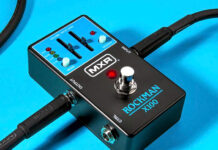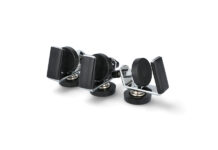![taylor-50th-feature-15[1]](https://www.promusic.news/wp-content/uploads/2024/07/taylor-50th-feature-15[1]-267x200.jpg)
Taylor Guitars – one guitar company, 50 years of innovation
Ad feature with Taylor Guitars
The acoustic guitar, as we know it today, doesn’t much resemble what it was like 200, 100 or indeed 50 years ago. Guitar-makers are constantly refining the formula, introducing new materials, designs, and technologies into the process – the guitar, of course, doesn’t evolve by itself. A huge part of the acoustic’s recent history has, undeniably, been Taylor Guitars.
Ever since it was founded by Bob Taylor and Kurt Listug in El Cajon, CA, in 1974, Taylor has sought out new approaches to making guitars – from groundbreaking glue-free neck joints to new bracing patterns to unconventional, sustainable tonewoods. As Taylor celebrates its 50th anniversary, let’s explore some of its most impactful contributions to the world of acoustic guitar making.
A slimmer acoustic neck
The playability of any guitar starts with the neck – the most important interface between musician and instrument. Taylor necks are, famously, some of the slimmest you’ll find on an acoustic – and from the brand’s inception in 1974, their comfortable, easy-to-play profile set the brand apart, even before it adopted CNC milling for extra-adjustable and extra stable necks.
The Grand Concert body shape
Photo by Adam Gasson / Guitar.com
Taylor debuted the Grand Concert guitar in 1984. Designed in collaboration with fingerstyle guitarist Chris Proctor, the instrument was a small-bodied alternative to the popular dreadnoughts and jumbos of the day. While those larger instruments offered powerful, room-filling sound, the Grand Concert had a much more articulate profile – perfect for players who wanted to experiment with more complex chordal approaches without being drowned out by their own guitar’s resonance. The Grand Concert also introduced a slightly wider fretboard to accommodate intricate fingerings, and features a dramatic cutaway for easy playability across the whole neck.
The first CNC-milled acoustics
In 1990, Taylor became the first acoustic guitar maker to make use of computer numerical controlled (CNC) milling, inspired by Tom Anderson’s adoption of the technology for electric guitars two years earlier. The CNC process allowed for unprecedented precision in the creation of both the guitars themselves and proprietary tools used in the factory. The consistency afforded by the technology allowed Taylor to continue to grow its business across the 1990s.
The patented NT neck design
Image: Eleanor Jane
Rather than just using CNC milling to speed up more traditional acoustic-making, Taylor would also embrace the new possibilities that the technology’s precision allowed. Modern taylor necks are made from three pieces of wood – although sourced from the same blank to ensure consistent density. The CNC milling process allows for the heel and the scarf-jointed headstock to be extra secure, and the neck as a whole to be more stable and straight, while the three-piece design reduces wood waste, as less of the blank is milled away than with a one-piece neck.
Taylor guitars featured a bolt-on neck joint from as early as 1976, using Bob Taylor’s own refined approach to the design. But the patented NT neck, introduced in 1999, redefined how the brand approached the joint entirely. Thanks to the adoption of precise CNC milling, Taylor was able to make the joint glue-free. This makes repairs and neck resets much, much easier, and as the neck angle can be easily adjusted with laser-cut precision spacers, action can be set low straight from the factory – meaning Taylor guitars are ensured a long lifetime of easy playability.
Grand Auditorium
While the Dreadnought shape was perfect for the needs of flatpickers, and the Grand Concert for those of fingerstyle players, the Grand Auditorium was introduced in 1994 with a body size that split the difference between the two approaches. The mid-sized model boasts, appropriately enough, a particularly articulate midrange, meaning it sits well alongside other instruments in a mix. Its versatility and appeal to players of all styles has seen it become Taylor’s best selling guitar shape.
A UV-cured finish
Image: Taylor Guitars
When you’re making thousands of guitars a year, the time it takes for their finish to cure is of the utmost importance. In 1995, working with Tom Anderson, Bob Taylor developed a new polyester-based finish that could be applied in a thinner overall coat. It could also be cured in a UV oven in just a matter of minutes, rather than over a matter of days – or longer – as with nitrocellulose finishes. While the shorter curing time had a huge impact on production efficiency, the thinner coat of finish also had less of a dampening effect on the natural sound of Taylor’s guitars.
The T5
In 2005, Taylor entered into the world of hybrid electric/acoustic guitars with the T5 and T5z. These guitars offer a hollow construction with a pair of futuristic-looking F-holes, but their defining feature was their combination of traditional acoustic and electric pickup systems. A unique five-way switch chooses between different combinations of a body-sensing pickup for acoustic tones, a lipstick-style bridge pickup and a concealed neck humbucker. These guitars were truly like no other hybrid instruments that came before them, and offered a much more cohesive combination of electric and acoustic approaches, far beyond what adding an electric pickup to a standard acoustic could ever achieve.
The GS Mini
Introduced in 2010 and based on a scaled-down version of its Grand Symphony body shape, Taylor’s GS Mini quickly became one of the most popular small-bodied acoustics out there. While it scaled down the Grand Symphony into a much physically smaller package, Taylor aimed to keep the sound big and bold – meaning players didn’t have to compromise on sonic presence with such a portable instrument.
V-Class Bracing
Image: Taylor Guitars
The history of the acoustic guitar can be traced via bracing patterns – not entirely, of course, but the introduction of a totally new approach is of course a major moment in the timeline of the instrument. In 2018, Taylor introduced the Andy Powers-designed V-Class bracing, heralded as a major step beyond standard ladder or X-bracing. It features two large braces in (as you might have guessed) a V shape, running along either side of the soundhole, joined by smaller braces perpendicular to the string path. This results in the centre of the soundboard being stiffened, which supports the strings’ vibration for stronger sustain, but the controlled flexibility across the entire top allows for extra volume.
Looking forward with sustainability
Taylor’s compact GT model debuted in Urban Ash – a sustainable and locally harvested wood source (Image: Adam Gasson/Guitar.com)
All these innovations would be for naught if Taylor doesn’t make its guitars sustainably. The brand has led multiple conservation efforts across its lifetime, often working directly with environmental groups and local communities to ensure wood is sourced responsibly. In 2001, Taylor became involved in a mahogany sourcing partnership with remote forest communities in Honduras, and was able to maximise guitar yield from each tree with modified cutting specifications.
Ebony is a notably difficult wood to source sustainably, and the world’s supply continues to face a range of challenges. As documented in The Ebony Project, in 2011, Taylor became co-owner of an ebony mill in Cameroon, and led the charge in educating the wider musical instrument industry about the problems the wood’s supply chain faces. Taylor also pushed for the acceptance of colour-variegated ebony alongside the more traditional jet-black wood.
In 2015, Taylor launched Siglo Tonewoods. A joint venture in Hawaii with Taylor’s supply partner Pacific Rim Tonewoods, the project’s goal is to ensure that selective harvesting and extensive reforesting can enable a completely sustainable supply of Hawaiian koa. The koa-sourcing efforts from this project have allowed Taylor to innovate with a series of all-koa instruments, bearing their own unique look and sonic character.
Most recently, Taylor has embraced another unconventional tonewood with the Urban Ash series. These guitars are made with timber from a very non-traditional source indeed – trees that had been removed from urban environments due to age or safety concerns. There’s not normally much of a market for this wood, however in reclaiming it for use in guitars, Taylor has opened up a new avenue for sourcing guitar-making materials.
Beyond tonewood
Image: Taylor Guitars
Taylor’s innovations go beyond materials, design and technology, however – while COVID-19 upended basically every industry on the planet, Taylor re-worked its factory to ensure guitar production could continue safely. And, over the pandemic, the brand became entirely employee-owned, giving the people who make its guitars a direct stake in its success. With Andy Powers also becoming president and CEO in addition to his role as Chief Guitar Designer in 2022, and Bob Taylor and Kurt Listug becoming senior board advisors, the brand seems ready to embark on its next 50 years of guitar innovation.
The post Taylor Guitars – one guitar company, 50 years of innovation appeared first on Guitar.com | All Things Guitar.
Source: www.guitar-bass.net












